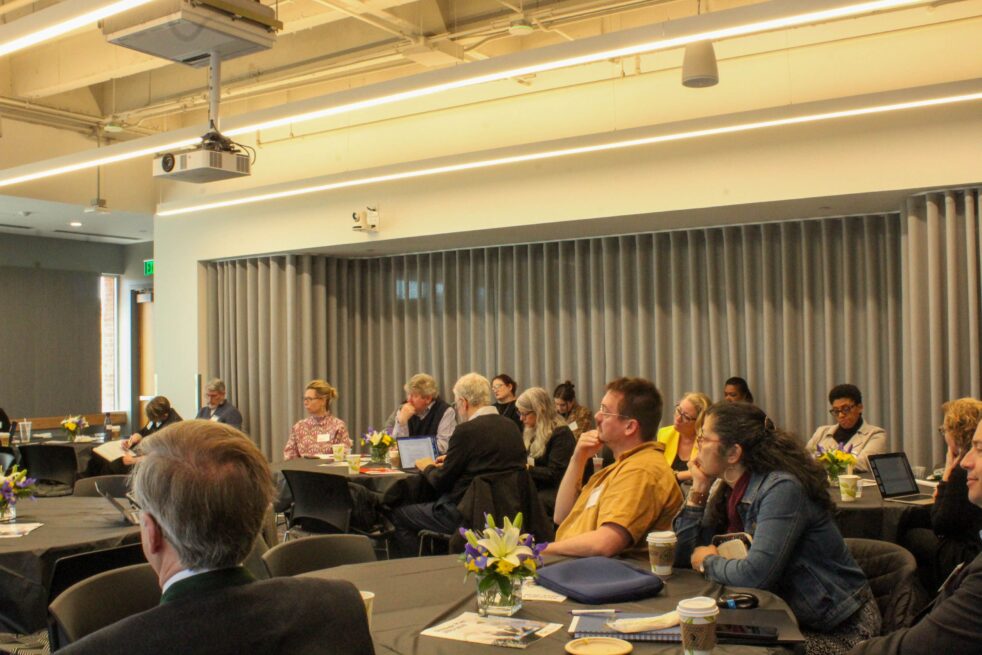Through the Faculty Futures program, the Ivan Allen College of Liberal Arts (IAC) hosted the Humanizing STEMM for the 21st Century Symposium earlier this month.
The event was held March 13 from 9 a.m. to 2:15 p.m. at the John Lewis Student Center.
The schedule of events consisted of two panels, a keynote and keynote responses, which featured many speakers and professors who came together to enrich the conversations facilitated by the symposium’s participants.
The goal of the symposium was to sample existing kinds of integration between HASS (Humanities, Arts and Social Sciences) and STEMM (Science, Technology, Engineering, Math and Medicine) at Tech.
Richard Utz, Senior Associate Dean of the IAC, was the spokesperson for the symposium and
helped to facilitate the event.
When asked about the inspiration behind the event, Utz said, “generally, the notion that higher education research/scholarship and teaching have become too siloed; a situation that prevents us from identifying and solving complex problems. Individual academic disciplines are too focused on their more narrowly defined methodologies to tackle complex and wicked issues.”
He went on to say, “if the pandemic has taught us one lesson, it is that we need many disciplines to work in concert (science, policy, communication, supply chain management) to succeed, and we need to learn that at our universities. The National Academies of Sciences, Technology, Engineering, Mathematics and Medicine (NASEM) have realized this need for integrating STEMM with the humanities, arts and social sciences, and they are actively promoting such integration, calling all these disciplines ‘branches from the same tree.’”
What the symposium aimed to do was understand and analyze why humanities and arts must coincide and become more integrated with STEMM.
Panelists in attendance had a wide range of disciplines and provided real-world examples of how the two fields were practically combined in their experience. Taking the conversation from the often theoretical “what if” into the realm of concrete applicability.
The benefits of integration are numerous and leaders in the field seemed to agree with this notion.
Furthering this idea during the symposium’s conversation, Utz said, “we wanted to take stock of what we do already, what works well, and how we might expand deliberate integration in the future.” The first panel focused on the benefits of integration and what purpose it would serve for attendees’ communities.
The second panel looked at how attendees can practice integration and employ different strategies to further the connection that lies between humanities and arts and STEMM.
The final keynote focused on “Finding a Binocular View for Science and the Humanities.”
Led by Lisa Margonelli, editor-in-chief of Issues in Science and Technology and professor of practice at Arizona State University, the keynote analyzed how looking at both fields together, rather than separately, may help to create a wider field of view allowing for more innovation and
integration in the future.
The symposium holds great benefits for the Tech community. Not only does the event bring members of the academic community together, it also helps to facilitate complex conversations.
Utz supported this idea when he said, “at traditional universities, the liberal arts are not in the habit of integrating with STEMM disciplines. At Georgia Tech, the liberal arts actively seek such integration. In fact, Ivan Allen College has numerous faculty with degree backgrounds in the sciences and technology.”
He went on to say, “Ivan Allen College students specifically want to study the liberal arts at a technological university because they seek an intellectual space in which the liberal arts and STEMM disciplines intersect. Because interdisciplinarity and collaboration are in the Ivan Allen College DNA, we will have a number of future conversations on how to create opportunities for future deliberate integration.”
Consequently, the conversation will not end at this symposium. The IAC is working to push for new events in hopes of fostering more discussion on integration.
Three IAC faculty who are currently Provost’s Teaching and Learning Fellows, Rachel Dean-Ruzicka, Bob Kirkman and Nathan Moon, are currently proposing workshop events on the specific value of the liberal arts for students in the scientific and technical disciplines.
Utz encourages students and faculty alike to get involved and educate themselves on the concept of integration of the often separate fields, at Tech and abroad.
To learn more about symposium, visit sites.gatech.edu/humanizingstemm/.
